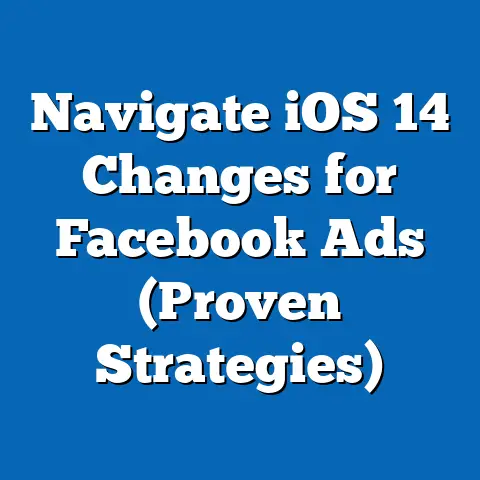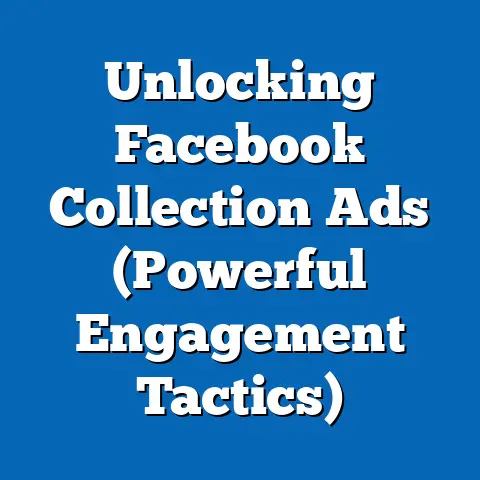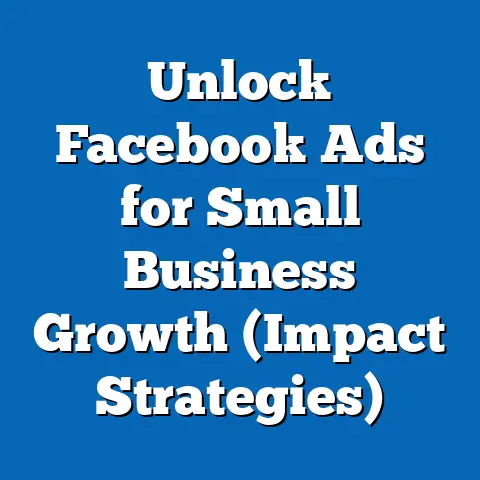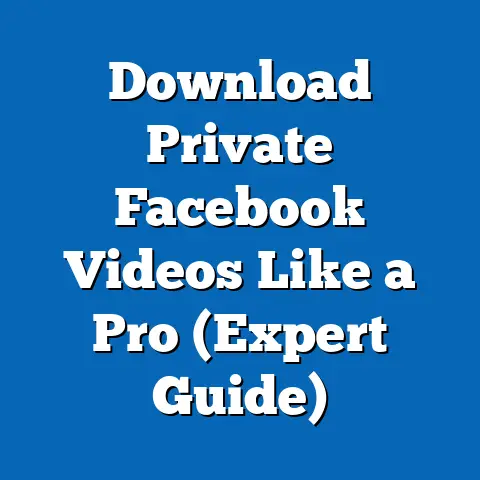Revive Facebook Ad Account: Boost Reactivation Strategies (Expert Insights)
Revive Your Facebook Ad Account: Boost Reactivation Strategies (Expert Insights)
Facebook! It’s been through ups and downs, algorithm changes, and the rise of new platforms. But let’s be real, it’s still a powerhouse for digital advertising. Despite the ever-evolving digital landscape, Facebook remains a leading platform for businesses looking to connect with their target audiences. I’ve seen firsthand how a well-crafted Facebook campaign can drive incredible results. I remember working with a local bakery that was struggling to get their name out there. We launched a Facebook ad campaign targeting people within a 5-mile radius who were interested in “pastries” and “coffee.” The result? Their weekend foot traffic doubled within weeks!
For many businesses, a Facebook ad account is more than just a tool; it’s a vital artery pumping life into their marketing efforts. It’s the engine that drives sales, boosts brand awareness, and connects them with potential customers. But what happens when that engine sputters and stalls? An inactive or restricted ad account can feel like a major setback. I’ve had clients come to me practically in a panic, their ad accounts suspended, their marketing plans thrown into disarray.
The good news? Reactivation is possible! I’m going to walk you through the common challenges and provide expert insights and actionable strategies to effectively revive your Facebook ad account. Don’t worry, we’ll get that engine roaring again!
Understanding Facebook Ad Account Restrictions
Why do Facebook ad accounts get the dreaded “restricted” label? There are several common culprits:
- Policy Violations: This is the big one. Facebook has strict advertising policies, and even unintentional violations can lead to restrictions. Think misleading claims, prohibited content, or targeting practices that discriminate.
- Low Engagement Rates: If your ads are consistently ignored or receive negative feedback (like lots of “hide ad” clicks), Facebook might see it as a sign of low-quality content and limit your account.
- Payment Issues: Failed payments or suspicious activity on your payment method can trigger a restriction.
- Suspicious Activity: Sudden changes in ad spend, targeting, or ad content can raise red flags and lead to a temporary suspension while Facebook investigates.
- Circumventing Systems: Trying to bypass Facebook’s review process or using tactics to game the system will almost certainly result in a restriction. I once saw a company try to use a cloaking technique to show different content to Facebook’s review bots than to actual users. Predictably, their account was permanently banned.
The implications of a restricted ad account can be significant. It can halt your ongoing campaigns, disrupt your marketing strategy, and impact your bottom line. A study found that businesses with restricted ad accounts experienced an average 20% decrease in website traffic and a 15% drop in sales. That’s why understanding the reasons for restrictions and having a solid reactivation strategy is crucial.
Key Takeaway: Understand the common reasons for Facebook ad account restrictions to avoid them in the first place.
Analyzing Your Account Health
Before you can fix the problem, you need to diagnose it. Fortunately, Facebook provides tools to assess your account health.
- Ads Manager: This is your central hub for managing your campaigns and monitoring performance. Pay close attention to the “Account Quality” section, which provides insights into any policy violations or restrictions.
- Business Manager: If you manage multiple ad accounts, Business Manager gives you a bird’s-eye view of their overall health. It also allows you to assign roles and permissions, ensuring that everyone on your team is following best practices.
Here are some key metrics to monitor:
- Ad Performance: Keep an eye on metrics like reach, impressions, clicks, and conversions. A sudden drop in performance could indicate an issue.
- Engagement Rates: Are people liking, commenting, and sharing your ads? Low engagement could signal that your content isn’t resonating with your audience.
- Audience Feedback: Pay attention to comments, messages, and reviews. Negative feedback can be a sign of problems with your ads or your overall brand reputation.
- Policy Violations: Check for any notifications or alerts about policy violations. Address them promptly to avoid further restrictions.
Understanding the performance of your past ad campaigns is critical for identifying patterns or issues that may have led to the account’s current state. Did you suddenly increase your ad spend? Did you target a new audience that didn’t respond well? Did you use any language or imagery that might have violated Facebook’s policies?
Key Takeaway: Regularly monitor your account health in Ads Manager and Business Manager to identify and address potential issues early on.
Crafting a Reactivation Plan
Okay, you’ve identified the problem. Now it’s time to craft a reactivation plan. This is a step-by-step guide to getting your account back in good standing.
Step 1: Review and Understand Facebook’s Advertising Policies.
This is non-negotiable. You need to know the rules of the game. Facebook’s advertising policies are comprehensive and cover everything from prohibited content to targeting practices. Take the time to read them carefully and make sure you understand them. I know it’s tedious, but it’s essential.
Step 2: Conduct a Comprehensive Audit of Past Campaigns.
Go through your past campaigns with a fine-tooth comb. Identify any ads that might have violated Facebook’s policies or performed poorly. Look for patterns in your targeting, ad copy, and imagery. Were there any common themes among the ads that were flagged or received negative feedback?
Step 3: Develop a Strategy for Compliance.
Based on your audit, develop a strategy for bringing your account into compliance. This might involve:
- Adjusting Ad Content: Rewriting ad copy, changing images, or removing prohibited content.
- Refining Targeting: Narrowing your audience or excluding certain demographics or interests.
- Updating Landing Pages: Ensuring that your landing pages are relevant to your ads and comply with Facebook’s policies.
Step 4: Create a Timeline for Implementing Changes and Monitoring Progress.
Set realistic goals and deadlines for implementing your changes. Monitor your account closely to see if your efforts are paying off. Are your ads being approved? Are your engagement rates improving? Are you seeing a decrease in negative feedback?
Example Reactivation Plan:
Let’s say your account was restricted for violating Facebook’s policy against misleading claims. Your reactivation plan might look like this:
- Week 1: Review Facebook’s policy on misleading claims. Audit all past campaigns for ads that might violate this policy.
- Week 2: Rewrite ad copy and change images to remove any misleading claims. Submit revised ads for review.
- Week 3: Monitor ad performance and engagement rates. Adjust targeting if necessary.
- Week 4: Continue monitoring and optimizing campaigns. Submit an appeal to Facebook to have the restriction lifted.
Having a structured reactivation plan is essential for demonstrating to Facebook that you’re serious about complying with their policies. It also helps you stay organized and focused on your goals.
Key Takeaway: A well-defined reactivation plan is crucial for getting your account back in good standing.
Implementing Best Practices for Future Campaigns
Reactivation is just the first step. To prevent future restrictions and promote sustainable ad performance, you need to implement best practices in all your campaigns.
- Regularly Review Ad Content: Don’t just set it and forget it. Review your ad content regularly to ensure that it’s still relevant and compliant with Facebook’s policies.
- Stay Updated on Policy Changes: Facebook’s policies are constantly evolving. Stay informed about the latest changes to avoid unintentional violations.
- Engage with Audiences Meaningfully: Don’t just bombard people with ads. Engage with them in a meaningful way by creating content that’s valuable and relevant to their interests.
- Diversify Ad Formats: Experiment with different ad formats, such as video ads, carousel ads, and collection ads, to keep your audience engaged.
- Optimize Targeting: Use Facebook’s targeting options to reach the right people with the right message. Don’t just target everyone.
I’ve found that diversifying ad formats is especially important. People get ad fatigue, and seeing the same type of ad over and over again can lead to them tuning out. By mixing things up, you can keep their attention and improve your engagement rates.
Key Takeaway: Implement best practices in all your campaigns to prevent future restrictions and promote sustainable ad performance.
Leveraging Facebook Support and Community Resources
You’re not alone in this! Facebook offers several support resources to help you deal with account issues.
- Help Center: This is your first stop for finding answers to common questions. The Help Center contains a wealth of information about Facebook’s advertising policies, best practices, and troubleshooting tips.
- Business Support Chat: If you can’t find the answer you’re looking for in the Help Center, you can contact Facebook’s Business Support team via chat. They can provide personalized assistance with your account issues.
In addition to Facebook’s official support resources, there are also many online communities and forums where advertisers share experiences and solutions regarding account reactivation. These communities can be a valuable source of information and support.
Don’t be afraid to reach out for help! Facebook’s support team is there to assist you, and there are many other advertisers who have gone through similar experiences.
Key Takeaway: Utilize Facebook’s support resources and engage with online communities to get help with your account issues.
Conclusion
Reviving a Facebook ad account can feel like a daunting task, but it’s definitely achievable. The key is to understand the reasons for the restriction, analyze your account health, craft a reactivation plan, implement best practices, and leverage Facebook’s support resources.
Remember, endurance and resilience are essential in navigating Facebook’s advertising landscape. Facebook is constantly changing, and you need to be prepared to adapt. Don’t get discouraged if you encounter setbacks. Just keep learning, experimenting, and refining your approach.
I encourage you to take proactive steps towards reviving your Facebook ad account by applying the strategies outlined in this article. Reactivation is not only possible but can lead to renewed success in your advertising efforts.
With the right approach and mindset, you can get your Facebook ad account back on track and start driving results for your business. Good luck, and happy advertising!





